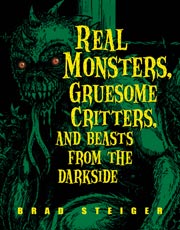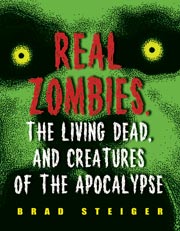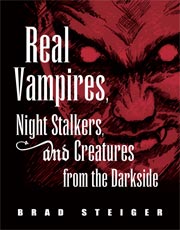When it first emerged from the shadows in Puerto Rico in the summer of 1995, the chupacabra ("goat sucker"), with its penchant for seizing goats and sucking their blood, immediately fascinated the public at large and created another deadly nightstalker to fear. From August 1995 into the twenty-first century, the monster has been credited with the deaths of thousands of animals, ranging from goats, rabbits, and birds to horses, cattle, and deer. While some argue that the creature is a new monster, perhaps even created in some scientist's clandestine laboratory, others point out that such vampiric entities have always existed and have been reported by farmers and villagers in Puerto Rico and Central and South America.
Indeed, rather than regarding the chupacabras as a recent arrival in the theatre of night stalkers, we need only go back to the accounts of shape-shifting amalgamations of monstrous entities summoned by the alchemists in Medieval Spain. It seemed clear to some investigators of the strange and unknown that these beings, slumbering in the psyches of the Hispanic people of Puerto Rico and Central and South America, had found a propitious moment in time and space to resurface. Now these perverse creatures need not follow the selective commands of their alchemical masters to savage their rivals in their smoky laboratories. The creatures were free to attack and feed on whatever victims they might find--human or animal.
Numerous eyewitnesses have described chupacabras as standing erect on powerful goat-like legs with three-clawed feet. The creature is often described as slightly over five feet in height, though some reports list it as over six and a half feet. Its head is oval in shape with an elongated jaw, a small, slit mouth, and fangs that protrude both upward and downward. Some witnesses have claimed to have seen small, pointed ears on its reptilian-like head and red eyes that glow menacingly in the shadows. Although its arms are thin, they are extremely powerful, ending in three-clawed paws.
Chupacabras appears to have the ability to change colors even though the creature is most often reported to have strong, coarse black hair covering its torso. Through some chameleon-like ability, the creature seems to be able to alter its coloration from green to grayish and from light brown to black, depending upon the vegetation that surrounds it. Another peculiarity of the beast is the row of quill-like appendages that runs down its spine and the fleshly membrane that extends between these projections, which can flare or contract and also change color from blue to green or from red to purple.
There have been reports that the chupacabras can fly, but others state that it is the beast's powerful hind legs that merely catapult it over one-story barns or outbuildings. It is those same strong legs that enable the creature to run at extremely fast speeds to escape its pursuers.
Within a short time after the night terrors began in Puerto Rico, reports of chupacabras began appearing in Florida, Texas, Mexico, and in Brazil's southern states of Sao Paulo and Parana. In Brazil, the ranchers called the monster, O Bicho, "the Beast." The descriptions provided by terrified eyewitnesses were also the same--a reptilian creature with thin arms, long claws, powerful hind legs, and dark gray in color.
On May 11, 1997, the newspaper Folha de Londrina in Parana State, Brazil, published the account of a slaughter that had occurred at a ranch near Campina Grande do Sul when in a single corral of twelve sheep were found dead and another eleven were horribly mutilated.
From April to September 2000, over 800 animals were slaughtered by the bloodsucker in Chile, and some witnesses to the bloody rampages of the creature described it as a large rodent, others as a mutant kangaroo, still others perceived it as winged, ape-like vampire.
A number of authorities even began to theorize that the chupacabras had been manufactured by some secret government agency for some nefarious purpose. Clergymen issued pronouncements stating that the demonic creatures were heralding the end of the world. UFO enthusiasts theorized that the monsters had been brought here by extraterrestrial aliens to test the planet's atmosphere preparatory to a mass invasion of Earth. Anthropologists and folklorists reminded people that tales of such mysterious, vampire-like monsters had been common in Central America for centuries.
A widely circulated story stated that Chilean soldiers had captured a chupacabras male, female, and cub that had been living in a mine north of Calama. Then, according to the account, a team of NASA scientists arrived in a black helicopter and reclaimed the chupacabras family. The creatures, so the story went, had escaped from a secret NASA facility in the Atacama Desert of northern Chile where the U.S. Space Agency was attempting to create some kind of hybrid beings that could survive on Mars.
On August 30, 2000, Jorge Luis Talavera, a farmer in the jurisdiction of Malpaisillo, Nicaragua, had enough of the nocturnal depredations of chupacabras. The beast had sucked the life from twenty-five of his sheep and thirty-five from his neighbor's flock, and he lay in wait with rifle in hand for its return. That night, Talavera accomplished what no other irate farmer or rancher had been able to do. He shot and killed a chupacabras.
Scott Corrales, Institute of Hispanic Ufology, reports that a specialist of veterinary medicine examined the carcass and acknowledged that it was a very uncommon creature with great eye cavities, smooth bat-like skin, big claws, large teeth, and a crest sticking out from the main vertebra. The specialist said that the specimen could have been a hybrid animal made up of several species, created through genetic engineering.
On September 5, 2000, the official analysis of the corpse by the university medical college was that Talavera had shot a dog. A furious Luis Talavera declared that the officials had switched carcasses. "This isn't my goatsucker," he groused as the college returned the skeleton of a dog for his disposal.
As we have entered the twenty-first century, chupacabras reports continue from nearly all the South American countries, Puerto Rico, and the Southwestern United States; and frightened and angry people complain that whatever chupacabras is, it continues to suck the blood from their livestock.
From The Werewolf Book: The Encyclopedia of Shape-Shifting Beings, Second Edition by Brad Steiger, (c) 2012 Visible Ink Press(R)
Steiger's homage to the beast within provides meaty facts for the lycanthropic in all of us.










